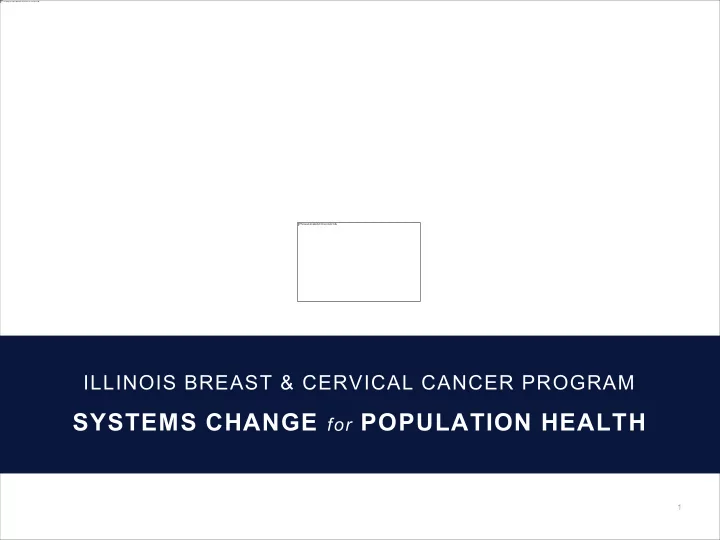

ILLINOIS BREAST & CERVICAL CANCER PROGRAM SYSTEMS CHANGE for POPULATION HEALTH 1
AMERICAN CANCER SOCIETY Build relationships, convene community and clinical experts, and collaborate with partners to innovate, shape opportunities, support the policy, systems, and environmental changes to improve: Breast and Cervical Cancers Screenings Colorectal Cancer Screenings Tobacco Cessation HPV Vaccination and Patient Education Healthy Eating and Active Living 2
W H AT AR E SYSTEMS? Systems are the tools and practices that inform, guide (and sometimes frustrate) your daily work.
W H Y FOC U S ON SYSTEMS? In a word . . . scale By taking a systems approach, you can reach more people, more effectively, and more efficiently, which leads to improved individual health outcomes, positive changes in population health and your bottom line.
H OW D O W E D O SYSTEMS C H AN GE? a) by fiat b) by trial and error c) by design 5
QU ALITY IMPR OVEMEN T Plan. Define the problem, plan EBI, establish baselines • Rural Health Inc. an FQHC in southern Illinois had a CRC screening rate of 13 percent. The national average was 67%. • They set a goal: Increase CRC screen rate to 18% in one year. Do. Implement the plan, collect the data • Using their EMR, they identified patients who were either due to be screened or who had not returned a take-home stool test. • Automated calls were placed to these patients and the number of calls and responses were recorded. 6
QU ALITY IMPR OVEMEN T Study. Measure outcomes and summarize results • Reviewed performance data. Calls did not perform as expected; patients were confused. RHI modified plan. Act. Refine the changes as needed; plan for next cycle • Replaced automated calls with screening reminder postcards. • After 12 months of intervention and focused follow through (one-on-one patient education, adapting to feedback and performance data), HRI increased their screening rate from 13 percent to 16.7 percent. 7
U SIN G EMR S TO D R IVE C H AN GE Shuntai Great Lake State Health -- Saginaw, Michigan • ACS saw opportunity: clinic had never looked at its screening rates so data was pulled from EMRs • Compared transactional screening rates versus all women over 40 years of age, which informed strategy. • Care coordinator used data to target reminder phone calls to eligible women who non-compliant or delayed. • Data capture and screening rates improved; on site mammography utilization increased. • 12 month, improved screening rate by 50 percent. • Positive performance > investments > sustainable 8
QI - - PLAN SC OR EC AR D S 9
QI - - PR OVID ER SC OR EC AR D Cancer Prevention Score Card for R. Thompson, MD 90 80 70 60 50 40 30 20 10 0 Breast % Cervical % HPV % Colorectal % Provider Practice National 10
PU BLIC ED U C ATION & OU TR EAC H Workplace Screening Reminders sent to all CTA employees. Baseline screening rate provided by health plan. Evaluation of post- reminder screening rates will be used to inform next steps. 11
12
13
BC C P C ASE STU D Y: TEXAS TBCCS contracted with ACS to work to convene working group to evaluate contract agencies, evaluate readiness to build a project and evaluation plan • Work began with one FQHC, Gateway Community Health • Data needs were identified and collection/reporting systems built. • Project activities were identified and stage activities over time Public Education and Outreach Screening Services and Care Coordination Organized Screening Systems Quality Assurance, Surveillance and Monitoring 14
• Map processes; identify opportunities for improvement. Cervical Cancer Process Mapping Results GAPS in Systems Processes identified 12 Systems Opportunities Recommended 12 Systems Change Practices in 8 Transition Systems Change Practices Completed 3 Systems Change Practices Not 1 Pursued • Publish progress reports and results • Gateway increased screen rate from 41.4 to 68.6 in 2 years. 15
TH E TEXAS TEAM American Cancer Society State Health & Primary Care Systems staff Texas Breast and Cervical Cancer Services BCCS Project Managers (2) BCCS Clinical Nurses (2) Director, BCCS Gateway Community Health Center Chief Executive Officer Chief Operating Officer Chief Medical Officer Director of IT Director of Patient Access Director of Women’s Clinic Director of Primary Clinic BCCS Coordinator Clinical Operations Director 16
QUESTIONS? Suzanne Elder Senior Director State Health Systems Caleb Nehring Primary Care Health Systems Manger 17
Recommend
More recommend